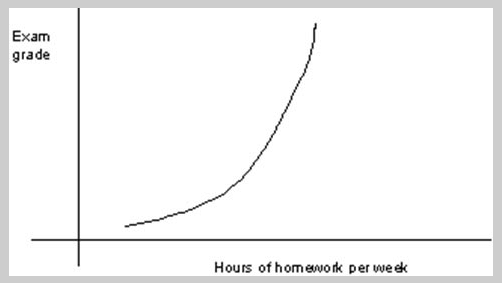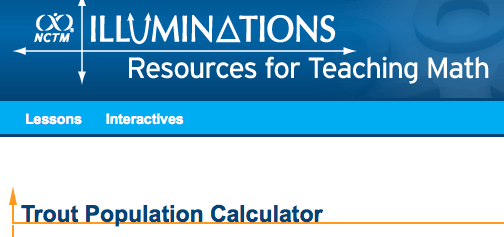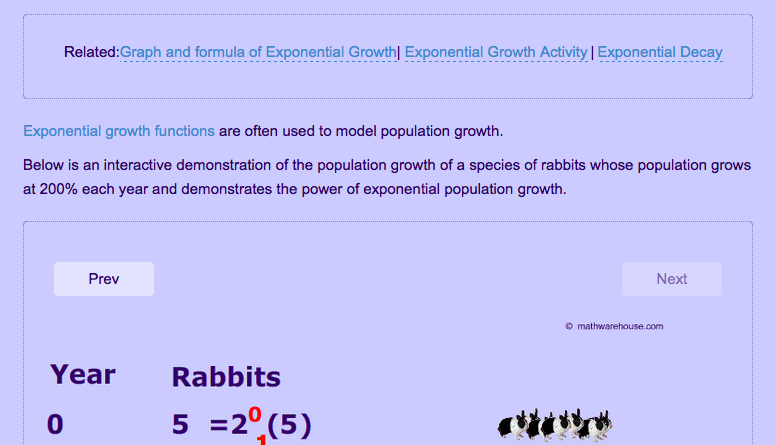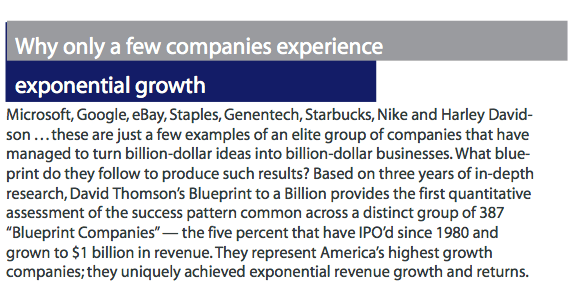Brief note: a time-out from art-related items to post an assignment for a Coursera class for assessment by peers.
Unit: Exponential Relationships

click for link to image
9th grade, but 8th graders are welcome!
Investigation 1: Exponential Growth
Welcome to our new unit in Connected Math, Exponential Relationships! We have five different investigations, and you will find yourself doing a lot of comparisons of exponential relationships with linear relationships. (Told you linear would never go away!) You can see an overview of the unit by clicking on the link above to see the parent information letter. DO NOT WAIT TO GET YOUR NEW UNIT BOOK from your district office – you don’t want to get behind!!
Here are two key pieces we will focus on:
UNIT GOALS (Specific Arizona Standards for this unit at the end of this investigation):
You…have previously studied linear growth, in which a fixed amount is repeatedly added to a beginning quantity to produce a sequence of values.
Exponential growth involves patterns that are based on multiplication rather than addition. For example, in the sequence 3, 9, 27, 81, 243, …, each term is 3 times the previous term. The basic goal in Growing, Growing, Growing is for…you…to learn to recognize situations, data patterns, and graphs that are modeled by exponential expressions, and to use tables, graphs, and equations to answer questions about exponential patterns.
You will ask yourself the following questions as we go through the unit:
- * Is the relationship between variables an example of exponential growth or decay? Why?
- • How can this relationship be detected in a table, graph, or equation? What is the growth factor?
- • What table, graph, or equation would model the data or the pattern in a graph relating the variables?
- • How could I answer questions about an exponential situation by studying a table, a graph, or an equation of the exponential relationship?
- • How does this exponential relationship compare to other relationships between variables I have studied?
Stuck? Email: ***************@***************
Now to the fun stuff: Investigation 1
- You will need: scissors and a sheet of paper (regular paper is fine, and you might be happier with a blank sheet)
- Your journal for record-keeping, notes, and solving problems
- A new anchor chart for vocabulary on a separate page in your journal – use a stickie tab on the page for easy reference to it.
- [Reference for peer readers on anchor charts – http://www.julieballew.com/A_Literate_Life/Photos/Pages/Anchor_Charts.html. Students will have other samples, since what I use I cannot share publicly (only in a classroom/online teaching setting) because of proprietary agreement with past employer)].
(Students have experience with anchor charts, and throughout the online lessons, I will have links to the unit anchor charts.)
1. Read on page 5, 1.1 Making Ballots and complete the short experiment.
2. Answer questions in your journal from page 6. Remember to indicate the investigation, number of the problem, and use complete sentences!
3. Upload your problem to the dropbox by ____________ for feedback from Mrs. Moran. (This should take no more than 1 day.)
4. Begin working on homework problems for this investigation: Practice problems on page 11 – 18: Everyone do #1-14, and then 3 others of your choice. Everyone do #33 – 38. (Due at the end of the week.)
Stuck? Email: ***************@***************
5. Read on page 6, 1.2 Requesting a Reward and add the new vocabulary to your anchor chart for this unit.
6. Complete the “Getting Ready” on page 6 in your journal.
7. Complete problem 1.2 on page 7 in your journal. Remember to indicate the investigation, number of the problem, and use complete sentences!
8. Upload your problem to the dropbox by ____________ for feedback from Mrs. Moran. (This should take no more than 1 day.)
9. Continue working on homework problems for this investigation: Practice problems on page 11 – 18: Everyone do #1-14, and then 3 others of your choice. Everyone do #33 – 38. (Due at the end of the week.)
Stuck? Email: ***************@***************
10. Read on page 8, 1.3 Making a New Offer and add the new vocabulary to your anchor chart for this unit.
11. Answer questions from page 9 in your journal. Remember to indicate the investigation, number of the problem, and use complete sentences!
12. Upload your problem to the dropbox by ____________ for feedback from Mrs. Moran. (This should take no more than o1 day.)
13. Check out this
video and try experimenting with values. Think about what you notice and try and make a connection between the video and the investigation.
Stuck? Email: ***************@***************
14. Continue working on homework problems for this investigation: Practice problems on page 11 – 18: Everyone do #1-14, and then 3 others of your choice. Everyone do #33 – 38. (Due at the end of the week.)
15. Log onto the class discussion forum (*******************address) and complete two responses. a) What are you discovering so far about exponential growth? and b) what differences do you notice between linear and exponential growth? (Due by the end of the week.) (Rubric http://www.mtsu.edu/ltanditc/docs/Discussion_Board_Rubrics.pdf)
16. Check out this
video and see about exponential growth in real-world examples. You might get a few ideas for your Mathematical Reflection.
17. Start your draft of your mathematical reflection on page 19.
18. Read page 10, 1.4 Getting Costs in Line.
19. Answer questions from page 10 in your journal. Remember to indicate the investigation, number of the problem, and use complete sentences!
20. Upload your problem to the dropbox by ____________ for feedback from Mrs. Moran. (This should take no more than 1 day.)
21. Upload your homework problems to the dropbox by ___________ for feedback from Mrs. Moran. (Due end of the week.)
Extra
video – if you want to dig a little deeper and are interested in growth in businesses –
22. Complete your mathematical reflection on page 19. Use your word processor to complete the assignment. Use complete sentences – FOLLOW THE RUBRIC you already use for these! This is due by the end of the week – allow yourself two days for draft and final copy.
23. Breath Deeply and congratulations! You’ve made a major start in understanding a very practical application of algebra!!!!
Deadlines:
Investigation 1.1 should be completed within a day.
Investigation 1.2 should be completed within a day
Investigation 1.3 should be completed within a day.
Investigation 1.4 should be completed within a day.
Homework Problems due end of the first week.
Discussion forum responses due the end of the first week.
Mathematical Reflection due the end of the first week.
STATE STANDARDS:
- HS.F-LE.A.1a. Distinguish between situations that can be modeled with linear functions and with exponential functions.
- HS.F-LE.A.1b. Prove that linear functions grow by equal differences over equal intervals, and that exponential functions grow by equal factors over equal intervals.
Mathematical Practice Standards:
- 1. Make sense of problems and persevere in solving them.
- 2. Reason abstractly and quantitatively.
- 3. Construct viable arguments and critique the reasoning of others.
- 4.Model with mathematics.
- 5.Use appropriate tools strategically.
- 6.Attend to precision.
- 7.Look for and make use of structure.
- 8.Look for and express regularity in repeated reasoning.
Copyright notice: all links are public domain and links are included by clicking on pictures. This unit is directly from Connected Math 2, published by Pearson. The conversion to an online format is the work of the instructor, Linda Moran, and cannot be reproduced without permission of the instructor.



